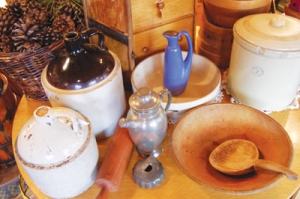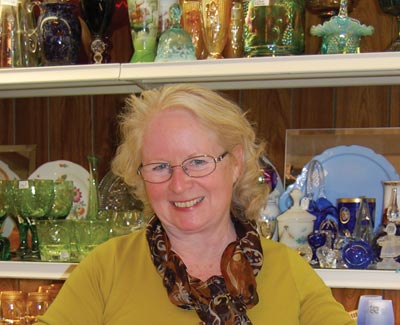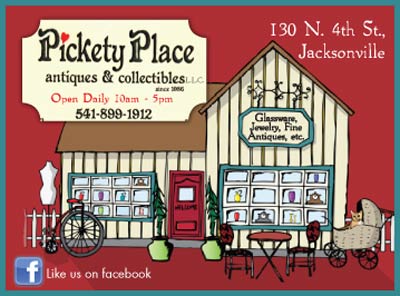Speaking of Antiquing – by Margaret Barnes, Pickety Place Antiques & Collectibles
The topic of Primitives is vastly overwhelming. I have seen fantastic primitives that date back to Colonial days. The early American settlers and pioneers set the standard that so many try to emulate today. One could begin collecting items from the early 20th century and still find many items that could create a charming primitive décor. Kitchen primitives are the most sought-after and most easy to incorporate into everyday life.
Crockery or Stoneware is perhaps one of the easiest things to begin collecting. Wire top crock jars with lids and rubber seals intact can create a charming display of food storage jars. They can be one color or two-tone brown and yellow clay.
Crocks were used as food storage and for pickling. Redwing crocks carry a distinctive blue and red wing with a number signifying the gallons of the crocks. Most crocks will carry a number signifying its size. Some larger crocks have wooden handles for lifting, but those 25 gallon crocks are pretty heavy with nothing inside. Can you imagine how heavy it would be filled with sauerkraut or beer? Even today, one can make crocks very useful throughout their house to hold kitchen utensils, magazines, towels or laundry. Many do not shy away from a surface crack or small chip, as that just adds charm.
 Food storage is still the biggest draw since so many of us are still making homemade sauerkraut and nothing works as well for fermenting than an old, lidded crock. Crocks were used in cold cellars and in creeks to keep butter and milk cold, as well as to preserve items as long as possible before refrigeration.
Food storage is still the biggest draw since so many of us are still making homemade sauerkraut and nothing works as well for fermenting than an old, lidded crock. Crocks were used in cold cellars and in creeks to keep butter and milk cold, as well as to preserve items as long as possible before refrigeration.
Bottles and bowls make up a good number of easy finds. Some dough bowls have been in the same family for generations and used to make thousands of loaves of bread. Mixing bowls in primary colors began taking over the common brown and ecru clay bowls in the 1930’s and ‘40’s and are still one of the most sought-after kitchen items.
Then, of course, there’s the good old whiskey jug! Everyone loves the classic brown jug. Even used as a musical instrument, the moonshiners of old would wrap their fingers around the handle and hoist them to their shoulders for a steady draw. Some young men are now collecting these jugs in gallon and half gallon sizes as growlers for craft beer. You are lucky to find one with an original cork or stopper, but must be careful with these old crocks since many, especially yellow-ware, were made with lead in the glaze. Salt thrown in the glaze before firing was common in stoneware.
Another easy place to begin collecting primitives is the simple wooden bowl. The wooden dough bowls of old were hewn from one piece of wood, identified by chisel marks. Before bowls were made on a lathe they were rough-cut and sanded using sand and scraping tools. Some of these early bowls can carry a hefty price. Butter bowls, complete with butter paddles were a common item in the pioneer kitchens. Then of course one would need the butter molds… and off you go. One thing leads to another. Just do some research as many items have been reproduced to fill a market that can only be quenched by the “real deal.”
Posted December 6, 2013



 Margaret Barns is co-owner of Pickety Place Antiques & Collectibles located at 130 N. 4th Street in Jacksonville. LIKE them on
Margaret Barns is co-owner of Pickety Place Antiques & Collectibles located at 130 N. 4th Street in Jacksonville. LIKE them on